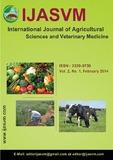| dc.description.abstract | An assessment of the performance and competitiveness of Somaliland livestock sector was
done using livestock value chain analysis. Results of the analysis revealed that livestock
production involving cattle, sheep, goats and camels is the region’s primary economic activity.
Livestock markets and infrastructure exist for both domestic and export trade. Market channels
are served by a number of interconnecting primary and secondary markets linked to several
production areas. Local markets involve livestock slaughter and marketing of meat to local
consumers. Livestock slaughter and marketing of meat suffer constraints that include poor
design and hygiene of slaughter facillities and lack of meat inspection services. Export markets
involve trade in live animals and raw hides and skins. Trading activities are facilitated by availability
of important animal handling facilities in livestock markets. The main players in the sector include
pastoralist producers, animal trekkers, livestock traders/exporters, brokers, livestock
transporters, slaughterhouses operators, butchers, meat traders, meat transporters and hides
skins traders. The Ministry of Livestock Development, Local Authorities, and Somaliland Chamber
of Commerce and Industry play a supportive role to the sector. Livestock productivity is affected
by occurrence of livestock diseases, scarcity of water and pastures due to recurrent droughts
and rangeland degradation, inadequate animal health and veterinary extension services and
loss of value along the livestock marketing chain. Productivity can be enhanced by improving
fodder production and conservation, water harvesting and provision of animal health extension
services. To enhance competitiveness of livestock export, there is need to develop livestock
disease testing facilities in livestock markets, as well as strengthen financal services to support
livestock exporters. On the other hand, competitiveness of meat marketing can be enhanced by
rehabilitation/improvement of slaughter and meat production and marketing facilities and services. | en_US |

